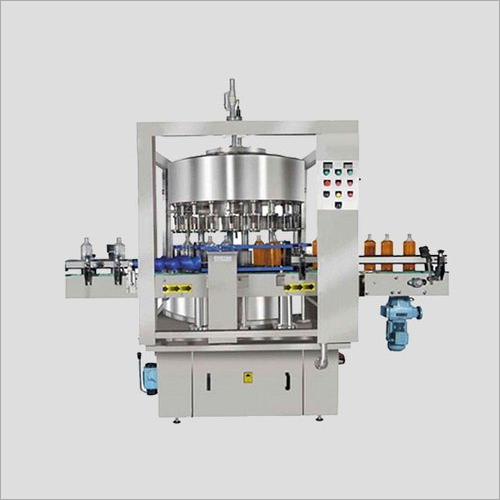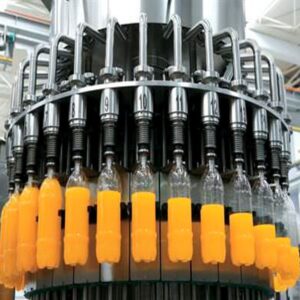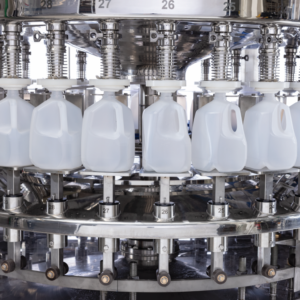Description
| Specwine-filling | tails |
|---|---|
| Machine Type | Automatic Wine Filling Machine |
| Capacity | 500 – 2000 bottles per hour (adjustable) |
| Filling Volume | 100 ml – 1000 ml (customizable) |
| Bottle Types Supported | Glass bottles (various shapes and sizes) |
| Filling Accuracy | ± 1% |
| Power Supply | 220Vwine-filling/60Hz (customizable) |
| Power Consumption | 3 kW |
| Control System | PLC (Programmable Logic Controller) |
| Material | Stainless steel 304 |
| Air Pressure | 0.6 – 0.8 MPa |
| Dimensions (L x W x H) | 2000 mm x 1200 mm x 1800 mm |
| Weight | 800 kg |
| Operating Interface | Touch screen display |
| Cleaning System | CIP (Clean-in-Place) system |
| Safety Features | Emergency stop button, safety guards, overload protection |
| Warranty | 1 year |
The wine-filling machine stands as a pinnacle of innovation within the winemaking industry, revolutionizing bottling wine with precision and efficiency. Designed to streamline production while maintaining the integrity of the wine, these machines are equipped with advanced technology and meticulous engineering.
At its core, the wine-filling machine automates the task of filling bottles with precise amounts of wine, eliminating human error and ensuring consistency in each bottle. Whether a small artisanal winery or a large-scale production facility, these machines cater to varying needs with customizable settings and adaptable features.
Operating seamlessly, the machine carefully fills bottles with the perfect amount of wine, minimizing spillage and wastage. Its speed and accuracy contribute to increased productivity, allowing wineries to meet growing demands without compromising on quality.
Beyond functionality, modern wine-filling machines often incorporate sustainability measures, such as energy efficiency and recyclable materials, aligning with the industry’s commitment to environmental stewardship.
Understanding the
Streamlining Wine Production with Advanced Filling Machines
In a winning world of winemaking, precision, and efficiency are paramount. Wineries worldwide are increasingly turning to advanced filling machines to streamline their production processes, ensuring consistent quality while meeting the demands of today’s market. Let’s explore how these machines revolutionize wine production while accommodating the industry’s diverse needs.
The Evolution of Wine-Filling Machines
Traditionally, the bottling process was labor-intensive, relying heavily on manual labor. However, as the industry evolved and demand surged, winemakers sought more efficient solutions. This led to the development of automated filling machines, marking a significant shift in winemaking practices.
Key Features and Functions
Modern wine-filling machines boast an array of features designed to enhance accuracy and efficiency. One such feature is the ability to precisely control the volume of wine dispensed into each bottle. This ensures consistency across batches and minimizes product wastage.
Versatility to Suit Every Need
Wineries come in various sizes and produce a wide range of wines, each with its unique characteristics. Filling machines are designed with versatility in mind, offering customizable settings to accommodate different bottle shapes, sizes, and fill levels. Whether it’s sparkling wines, still wines, or even specialty blends, these machines can adapt to the specific requirements of each product.
The Impact on Production Efficiency
Boosting Output Without Compromise
By automating the filling process, wineries can significantly increase their production capacity without sacrificing quality. These machines operate at high speeds, allowing for swift bottling and packaging, thereby reducing downtime and meeting tight deadlines. As a result, wineries can fulfill orders promptly and capitalize on market opportunities more effectively.
Reducing Labor Costs and Human Error
Manual bottling processes are not only time-consuming but also prone to human error. Filling machines mitigate these risks by automating repetitive tasks, minimizing the need for manual intervention. This not only reduces labor costs but also ensures greater consistency and accuracy in the final product.
Ensuring Quality and Consistency
Wine is a delicate product, susceptible to damage from exposure to oxygen and contaminants. Filling machines are equipped with features such as inert gas purging and sterile filling environments to protect the wine from oxidation and microbial spoilage. This helps preserve the wine’s flavor profile and extends its shelf life, ensuring that consumers enjoy a fresh and high-quality product with every bottle.
Meeting Stringent Regulatory Standards
The wine industry is subject to strict regulatory standards regarding labeling, packaging, and product quality. Filling machines help wineries adhere to these standards by providing accurate volume measurements and ensuring proper sealing and labeling of bottles. This not only enhances consumer confidence but also safeguards the winery’s reputation and compliance with industry regulations.
Embracing Sustainability
In an era of heightened environmental awareness, sustainability has become a top priority for many wineries. Filling machines play a crucial role in this endeavor by minimizing resource consumption and waste generation. From energy-efficient operation to the use of recyclable materials in packaging, these machines help wineries reduce their environmental footprint and contribute to a more sustainable future for the industry.
Types of wine filling machine
1. Gravity-Fed Filling Machines:
Gravity-fed filling machines operate on a simple principle: gravity. Wine flows from a higher reservoir into bottles positioned below, filling them gradually and evenly. These machines are ideal for filling still wines and are particularly suited for small to medium-sized wineries seeking a cost-effective solution with minimal mechanical complexity.
2. Vacuum Filling Machines:
Vacuum filling machines employ vacuum pressure to draw wine into bottles, ensuring precise filling levels and minimizing oxygen exposure. By removing air from the bottle before filling, vacuum fillers help preserve the wine’s freshness and prevent oxidation. This type of filling machine is suitable for a wide range of wines, including both still and sparkling varieties.
3. Piston Filling Machines:
Piston-filling machines utilize a piston-driven mechanism to dispense precise volumes of wine into bottles. The piston moves up and down, drawing wine from a reservoir and filling bottles with accuracy and consistency. These machines are highly versatile, and capable of handling various bottle shapes and sizes, making them popular choices for medium to large-scale wineries with diverse product lines.
4. Rotary Filling Machines:
Rotary filling machines feature a rotating carousel or turntable with multiple filling heads, allowing for simultaneous filling of multiple bottles. Bottles move nonlinearly and are filled sequentially, maximizing throughput and efficiency. Rotary fillers are well-suited for high-volume production environments, offering fast and continuous operation while maintaining accuracy and precision.
5. Overflow Filling Machines:
Overflow filling machines utilize a unique principle where excess liquid overflows from bottles, ensuring consistent fill levels and minimal foaming. This type of filler is commonly used for filling wine bottles with fine-filling shapes or narrow necks, as it prevents spillage and ensures a clean finish. Overflow fillers are suitable for still wines and are often preferred for their gentle handling of delicate products.
6. Inline Filling Machines:
Inline filling machines operate linearly, with bottles moving along a conveyor belt while being filled sequentially. These machines are highly customizable, allowing for precise control over filling volumes, speeds, and bottle handling. Inline fillers are versatile and adaptable to various production layouts, making them suitable for both small artisanal wineries and large-scale production facilities.
Applications of wine filling machine
1. BoWine-filling Wines:
One of the primary applications of wine-filling machines is bottling still wines. Whether it’s a robust red, a crisp white, or a refreshing rosé, filling machines ensure consistent fill levels and accurate volume measurements, maintaining the quality and integrity of the wine throughout the bottling process.
2. Filling Sparkling Wines:
Filling machines equipped with specialized features, such as counter-pressure filling heads, are used for bottling sparkling wines. These machines preserve the wine’s effervescence by minimizing agitation and preventing excessive foaming during filling, ensuring that each bottle of sparkling wine retains its characteristic bubbles and freshness.
3. Packaging Wine in Various Bottle Sizes:
Wine-filling machines are adaptable to different bottle sizes, allowing wineries to package their products in a range of formats, from standard 750ml bottles to magnums, splits, and even miniature bottles. This versatility enables wineries to cater to diverse consumer preferences and market demands effectively.
4. Customizing Fill Levels:
Winemakers havWine-fillingility to customize fill levels according to their preferences and branding requirements. Filling machines allow precise control over fill volumes, ensuring consistency across batches while accommodating variations in bottle shapes, label designs, and marketing strategies.
5. Handling Specialty Wine Blends:
For wineries producing specialty wine blends or limited-edition releases, filling machines offer the precision and flexibility needed to handle unique formulations. Whether it’s a complex cuvée or a small-batch experiment, these machines ensure that each bottle receives the exact blend specified by the winemaker, maintaining the wine’s intended character and flavor profile.
6. Integrating with Labeling and Packaging Systems:
Wine-filling machines can be seamlessly integrated with labeling and packaging systems, creating a fully automated production line. This integration streamlines the entire bottling process, from filling to labeling and packaging, reducing labor costs and minimizing the risk of errors or inconsistencies.
7. Ensuring Compliance with Regulatory Standards:
Wineries must comply with regulatory standards regarding labeling, packaging, and product quality. Filling machi-small-batch ensures compliance by providing accurate volume measurements, consistent fill levels, and proper sealing and labeling of bottles, helping wineries meet regulatory requirements and maintain consumer trust.
8. Enhancing Production Efficiency:
By automating the bottling process, filling machines significantly enhance production efficiency, allowing wineries to increase output while reducing labor costs and downtime. These machines operate at high speeds, bottling hundreds or even thousands of bottles per hour, enabling wineries to meet demand and capitalize on market opportunities effectively.
9. Facilitating Small Batch Production:
Filling machines are not limited to large-scale production facilities; they are arwine-fillingneficial for small batch and boutique wineries. With their customizable settings and adaptable features, these machines enable small producers to maintain quality and consistency in their products while optimizing their production processes for efficiency and cost-effectiveness.
10. Supporting Sustainable Practices:
Many filling machines incorporate sustainability features wine-filling energy-efficient operation, recyclable materials, and minimal resource consumption. By reducing waste and environmental impact, these machines align with wineries’ sustainability goals and contribute to a more eco-friendly approach to winemaking.
Functionalities of wine-filling machine
1. Precise Volume Control:
One of the primary functionalities of wine-filling machines is precise volume control. These machines are equipped with mechanisms that accurately measure and dispense the desired volume of wine into each bottle, ensuring consistency across batches and minimizing product wastage.
2. Wine-filling Levels:
Winemakers have the flexibility to adjust fill levels according to bottle size, wine type, and branding requirements. Wine-filling machines allow for variable fill levels, ensuring that each bottle is filled to the desired height while maintaining a consistent appearance on the shelf.
3. Bottle Handling Adaptability:
From standard wine bottles to specialty formats such as magnums and splits, wine-filling machines are designed to handle a variety of bottle shapes and sizes. Adjustable conveyors, grippers, and filling heads accommodate different bottle configurations, allowing wineries to package their products in various formats.
4. Oxygen Mitigation:
Oxidation can negatively impact the quality and shelf life of wine. Wine-filling machines incorporate features such as inert gas purging ing an aWine-filling line to minimize oxygen exposure during the bottling process. By creating a controlled atmosphere inside the bottle, these machines help preserve the wine’s freshness and flavor profile.
5. Counter-Pressure Filling for Sparkling Wines:
Filling machines equipped with counter-pine-filling heads are specifically designed for bottling sparkling wines. These machines maintain carbonation levels by filling bottles under pressure, minimizing agitation and foam formation. Counter-pressure filling ensures that each bottle of sparkling wine retainWine-fillingescence and quality.
6. Gentle Handling of Delicate Wines:
Some wines, particularly those with delicate aromas and flavors, require gentle handling to preserve their integrity. Wine-filling machines feature soft-touch filling heads and smooth transfer mechanisms to minimize agitation and prevent damage to the wine. This gentle handling ensures that the wine reaches consumers in optimal condition.
7. Automatic CappiWine-filling:
In addition to filling bottles, wine-filling machines often include automatic capping and sealing systems. These systems apply caps or corks to bottles with precision and consistency, ensuring a secure seal that prwine-fillingwine’s freshness and prevents leakage.
8. Integrate with Labeling Systems:
Wine-filling machines can be seamlessly integrated with labeling systems to create a fully automated bottling line. Integrated systems synchronize filling, capping, and labeling processes, reducing downtime and minimizing the risk of errors or inconsistencies in product packaging.
9. Cleaning and Sanitization:
Maintaining cleanliness and sanitation is essential in winemaking to prevent contamination and ensure product safety. Wine-filling machines feature automated cleaning and sanitization cycles that thoroughly clean and sterilize the equipment between production runs, minimizing the risk of cross-contamination.
10. Data Monitoring and Analysis
Some wine-filling machines are equipped with advanced monitoring and control systems that collect data on filling performance, productivity, and quality metrics. Wineries can analyze this data to optimize production processes, identify areas for improvement, and maintain consistent quality standards.
Frequently Asked Questions
- What is a wine-filling machine?
A wine-filling machine is a piece of equipment used in the winemaking industry to automate the process of filling wine bottles and wine-filling volumes of wine.
- How does a wine-filling machine work?
Wine-filling machines typically operate by drawing wine from a reservoir and dispensing it into bottles using mechanisms such as gravity, vacuum pressure, or piston-driven pumps.
- Whine-filling wine-filling can be fille-wine-filling machines.
Wine-filling machines can be used to fill a wide range of wines, including still wines (red, white, rosé), sparkling wines, and specialty blending-filling the benefits of online-following-filling machines?
The benefits of wine-filling machines include increased production efficiency, precise volume control, reduced labor costs, minimized product wastage, and improved wine-fillingistency.
- Are wine-filling maWine-fillingble forWine-fillings?
Yes, wine-filling machines come in various sizes and configurations, making them suitable for small artisanal wineries as well as large-scale production facilities.
- Does wine fill wine-wine-filling regular maintenance?
Yes, like any wine-filling equipment, wine-filling machines require regular maintenance to ensure optimal performance. This may include cleaning, lubrication, and periodic inspection of wine-fillings.
- Can wine-filling machines handle different bottle sizes shine-filling machines are designed to accommodate various bottle sizes and shapes, offering adjustable settings and customizable features to meet the specific needs of wineries.
- How do wine-filling machines prevent oxygen exposure to the wine?
Wine-filling machines may incorporate features such as inert gas purging or vacuum filling to minimize oxygen exposure during the bottling process, thereby preserving the wine’s freshness and flavor.
- Are wine-filling machines easy to operate?
While wine-filling machines may have a learning curve, they are generally designed to be user-friendly, with intuitive controls and straightforward operation procedures.
- Can wine-filling machines be integrated with other bottling line equipment?
Yes, wine-filling machines can be seamlessly integrated with labeling, capping, and packaging equipment to create a fully automated bottling line, maximizing efficiency and productivity.





